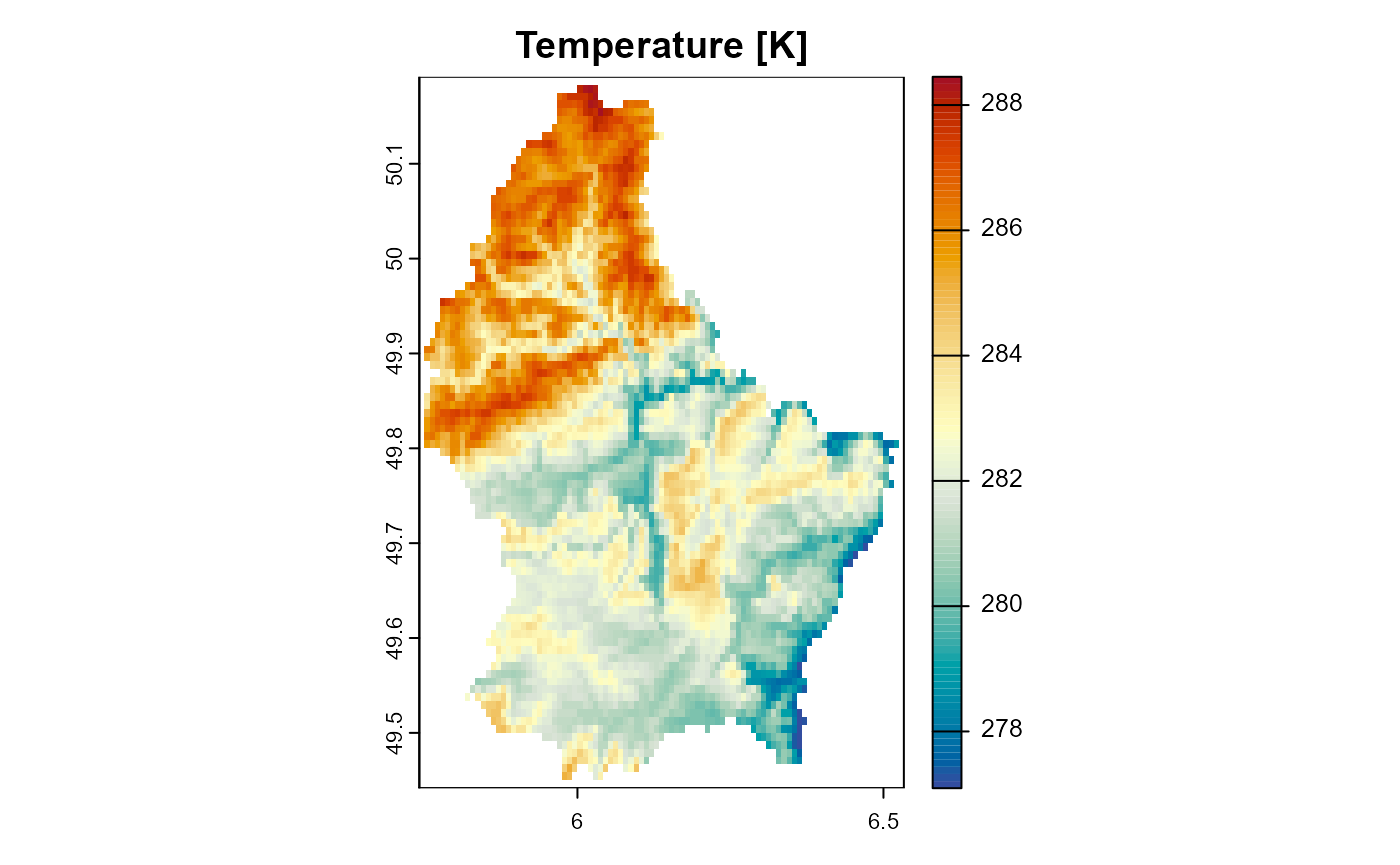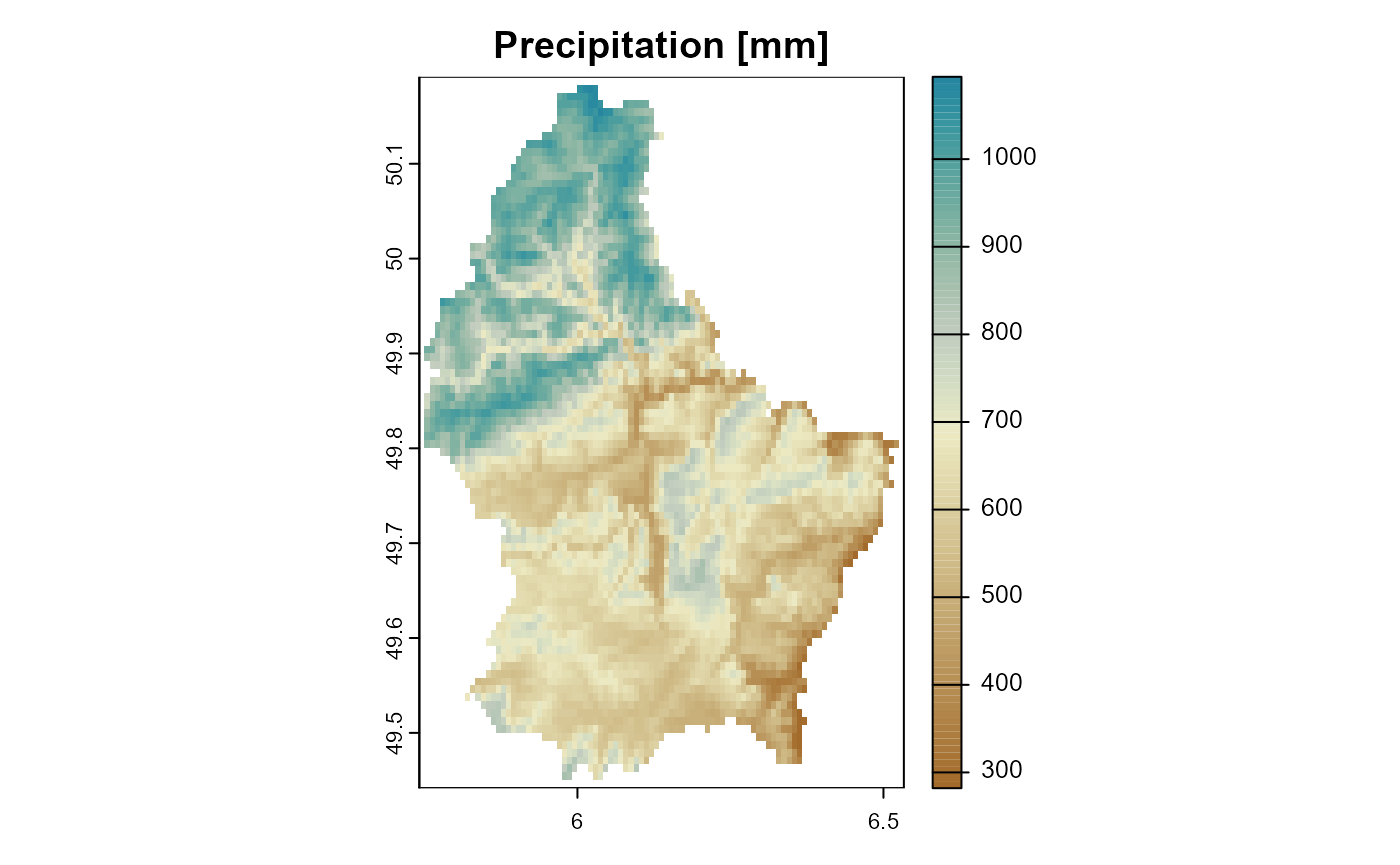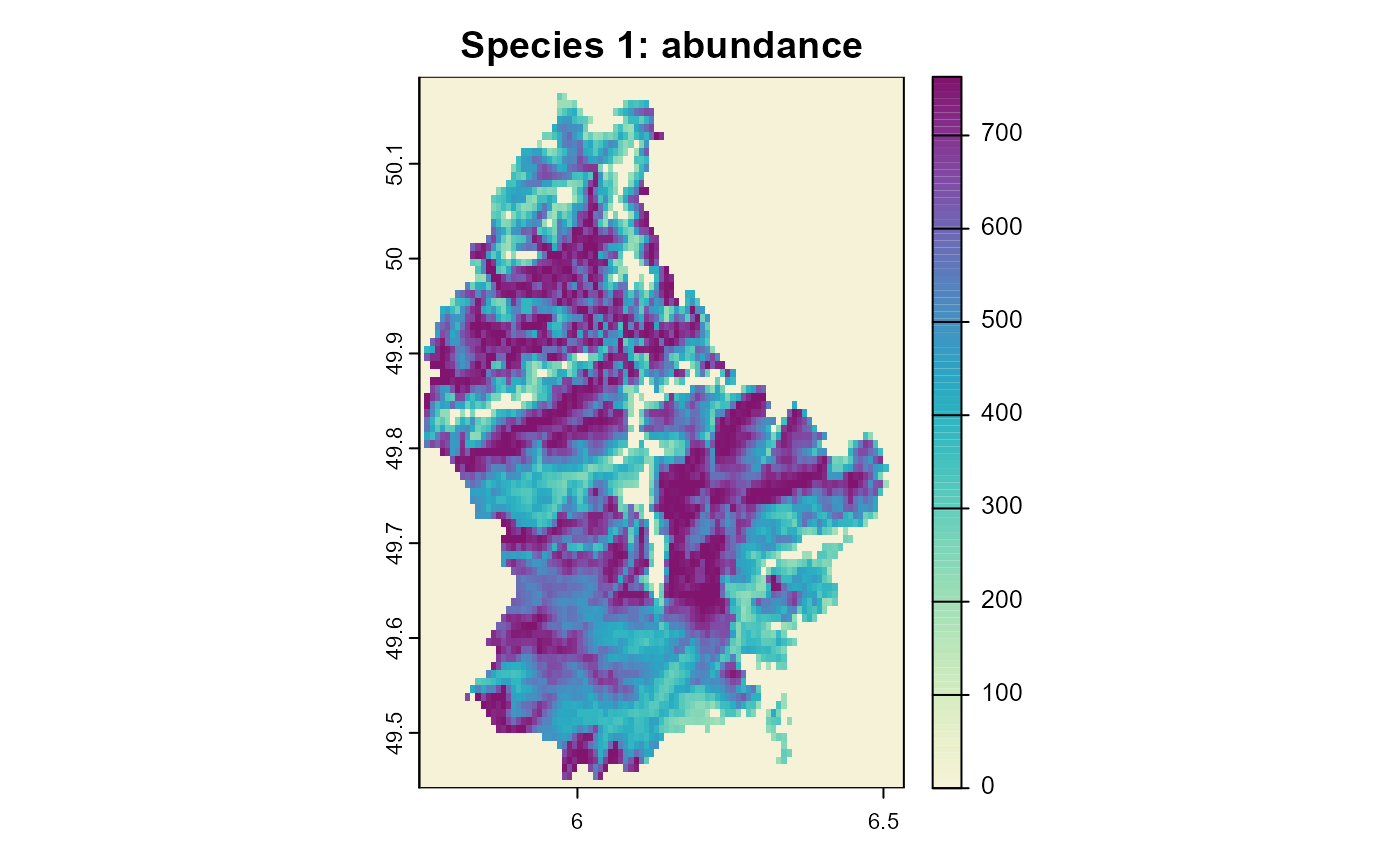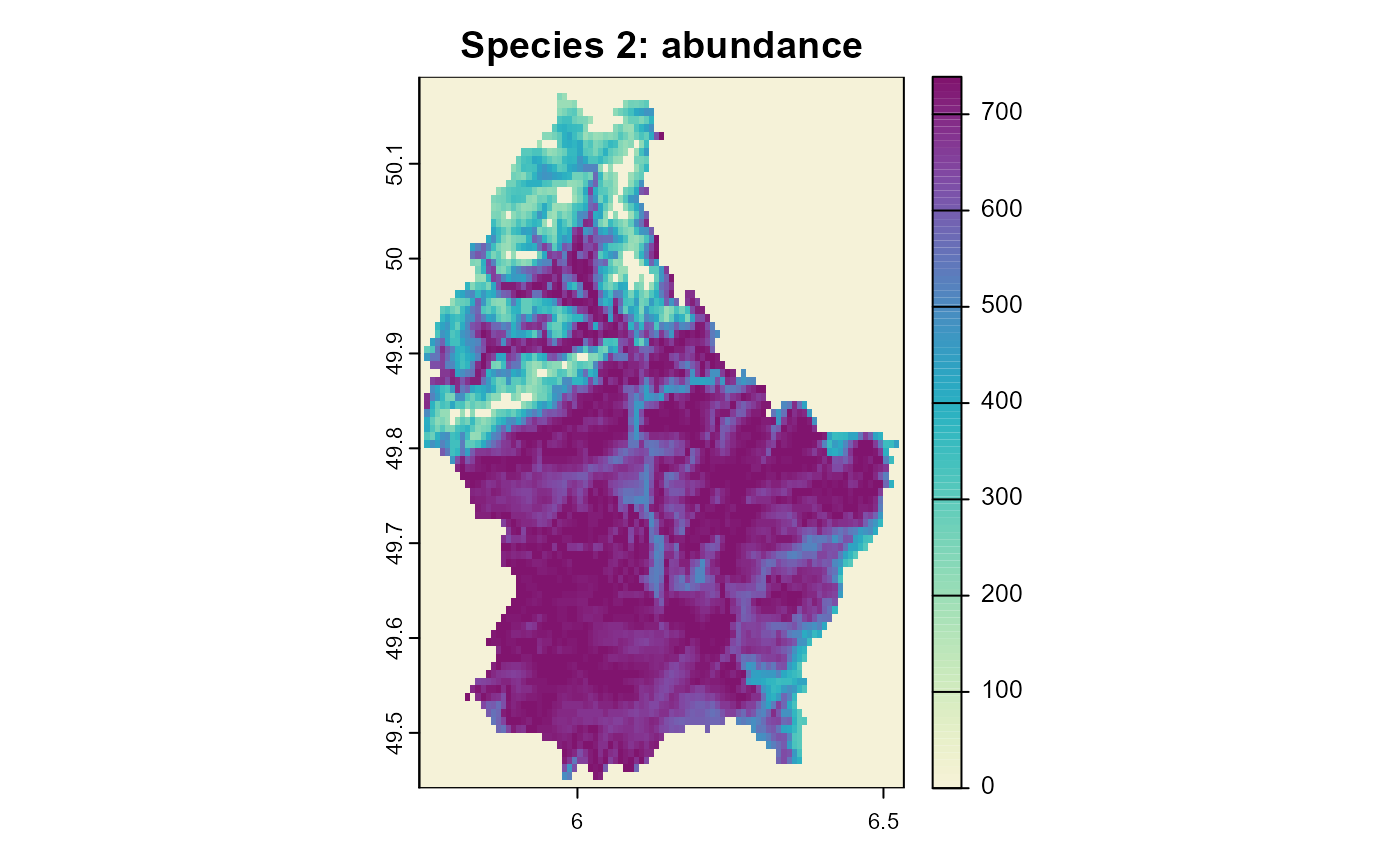
03: Niche suitability
Fallert, S. and Cabral, J.S.
Source:vignettes/A03_niche_suitability.Rmd
A03_niche_suitability.RmdOne of the main study question in ecology is the relationship between environmental conditions and species occurence. This tutorial will show how we can use information about the target species (e.g. preferred temperature and thermal limits) to implement a habitat suitability model in metaRange.
In a second step, we will use the calculated habitat suitability to inform the reproduction rate and carrying capacity in the population model. This allows us to see which populations are viable over time without the need for an arbitrary “suitability cutoff” value. For this, we will create a landscape with two environmental variables (temperature and precipitation) and then add two similar species to it that only differ in their environmental preferences.
At the end we can run the simulation and compare how this difference affects the distribution of the species.
Setup
We create the example landscape by arbitrarily scaling the example raster to ranges that are natural for both temperature and precipitation.
library(metaRange)
#> Warning: package 'metaRange' was built under R version 4.3.3
#> metaRange version: 1.1.4
library(terra)
#> terra 1.7.55
set_verbosity(2)
# find the example raster file
raster_file <- system.file("ex/elev.tif", package = "terra")
# load it
r <- rast(raster_file)
# adjust the values
temperature <- scale(r, center = FALSE, scale = TRUE) * 10 + 273.15
precipitation <- r * 2
terra::plot(
temperature,
col = hcl.colors(100, "RdYlBu", rev = TRUE),
main = "Temperature [K]"
)
Figure 1: The temperature of the example landscape. Only the first layer of 10 identical ones is shown.
terra::plot(
precipitation,
col = hcl.colors(100, "Earth"),
main = "Precipitation [mm]"
)
Figure 2: The precipitation of the example landscape. Only the first layer of 10 identical ones is shown.
Creating the simulation and species
In the previous tutorial we always created an SDS as input that has
the same number of layers as the simulation time steps. This was mainly
done to highlight the concept that one layer in the SDS represents the
conditions in one time step. In the case where the evironment is static
and does not change over time, this process is a bit tedious and also
might occupy more memory than necessary. Because of that, metaRange
provides the method set_time_layer_mapping(), which allows
us to just tell the simulation “use this one layer for every time step”.
This means we can just create an SDS that has only one layer:
landscape <- sds(temperature, precipitation)
names(landscape) <- c("temperature", "precipitation")
# how many layer are in the sds:
terra::nlyr(landscape)
#> [1] 1 1Create the simulation:
sim <- create_simulation(
source_environment = landscape,
ID = "example_simulation",
seed = 1
)
#> number of time steps: 1
#> time step layer mapping: 1
#> added environment
#> class : SpatRasterDataset
#> subdatasets : 2
#> dimensions : 90, 95 (nrow, ncol)
#> nlyr : 1, 1
#> resolution : 0.008333333, 0.008333333 (x, y)
#> extent : 5.741667, 6.533333, 49.44167, 50.19167 (xmin, xmax, ymin, ymax)
#> coord. ref. : lon/lat WGS 84 (EPSG:4326)
#> source(s) : memory
#> names : temperature, precipitation
#>
#> created simulation: example_simulationAnd then adjust the number of time steps and the layer that are used each time step, by calling:
# use layer 1 for 10 time steps
sim$set_time_layer_mapping(rep_len(1, 10))
#> number of time steps: 10
#> time step layer mapping: 1, 1, 1, 1, 1, 1, 1, 1, 1, 1Now we can continue by adding the species.
sim$add_species(name = "species_1")
#> adding species
#> name: species_1
sim$add_species(name = "species_2")
#> adding species
#> name: species_2Adding traits to species
Additionally to the traits introduced in the previous tutorials we
now also add a trait called climate_suitability, where we
will store the information about how suitable the climate conditions are
in each cell for the population that lives there.
sim$add_traits(
species = c("species_1", "species_2"),
population_level = TRUE,
abundance = 500,
climate_suitability = 1,
reproduction_rate = 0.3,
carrying_capacity = 1000
)
#> adding traits:
#> [1] "abundance" "climate_suitability" "reproduction_rate"
#> [4] "carrying_capacity"
#>
#> to species:
#> [1] "species_1" "species_2"
#> The traits in the above example are clearly traits that need to be
stored for each population (i.e. they need to be spatially explicit).
Contrary to that, some traits may not require to be stored at the
population level. In this example, we assume that the environmental
preferences of a species are the same for all populations. This means
that when we add these traits, we can set the parameter
population_level to FALSE so that the traits
are added as they are, without expanding them to the extent of the
landscape.
As mentioned in the introduction paragraph, we will give both species different environmental preferences for the two environmental variables in the simulation environment (temperature & precipitation).
Note that the names of the traits are arbitrary and can be chosen by the user and that there is no predetermined connection between e.g. “min_temperature” and the temperature variable in the environment. To establish these connections, the user needs to add processes to the species that access the correct traits and use them in a sensible way (This is why meaningful trait names are important).
sim$add_traits(
species = "species_1",
population_level = FALSE,
max_temperature = 300, # Kelvin
optimal_temperature = 288, # Kelvin
min_temperature = 280, # Kelvin
max_precipitation = 1000, # mm
optimal_precipitation = 700, # mm
min_precipitation = 200 # mm
)
#> adding traits:
#> [1] "max_temperature" "optimal_temperature" "min_temperature"
#> [4] "max_precipitation" "optimal_precipitation" "min_precipitation"
#>
#> to species:
#> [1] "species_1"
#>
sim$add_traits(
species = "species_2",
population_level = FALSE,
max_temperature = 290,
optimal_temperature = 285,
min_temperature = 270,
max_precipitation = 1000,
optimal_precipitation = 500,
min_precipitation = 0
)
#> adding traits:
#> [1] "max_temperature" "optimal_temperature" "min_temperature"
#> [4] "max_precipitation" "optimal_precipitation" "min_precipitation"
#> to species:
#> [1] "species_2"
#> Adding processes
Calculate the suitability
To calculate the suitability, we use the metaRange function
calculate_suitability() that is based on an equation
published by Yin et al. in 1995 [Ref. 1] and simplified by Yan and Hunt
in 1999 [eq:4 in Ref. 2]. The function takes the three cardinal values
of an environmental niche (minimum tolerable value, optimal vale and
maximum tolerable value) and constructs a suitability curve based on a
beta distribution.
min_value <- 270
opt_value <- 285
max_value <- 290
x <- seq(min_value, max_value, length.out = 100)
y <- calculate_suitability(max_value, opt_value, min_value, x)
plot(x, y, type = "l", xlab = "Temperature [K]", ylab = "Suitability")
Figure 3: Example suitability curve for the temperature niche of species 2.
In the following code we add a process to both species that calculates the suitability for precipitation and temperature and then multiplies the values to create a joint suitability over the two environmental niches. Note that one could also define a custom function to calculate the suitability, if this built-in function does not adequately describe the ecology of the target species.
Suitability
sim$add_process(
species = c("species_1", "species_2"),
process_name = "calculate_suitability",
process_fun = function() {
self$traits$climate_suitability <-
calculate_suitability(
self$traits$max_temperature,
self$traits$optimal_temperature,
self$traits$min_temperature,
self$sim$environment$current$temperature
) *
calculate_suitability(
self$traits$max_precipitation,
self$traits$optimal_precipitation,
self$traits$min_precipitation,
self$sim$environment$current$precipitation
)
},
execution_priority = 1
)
#> adding process: calculate_suitability
#> to species:
#> [1] "species_1" "species_2"
#> Reproduction
As in the previous tutorials, we use a Ricker reproduction model to calculate the new abundance of the species, but this time we let both the carrying capacity and the reproduction rate (for each species and population) depend on the suitability of the local environment / habitat.
sim$add_process(
species = c("species_1", "species_2"),
process_name = "reproduction",
process_fun = function() {
self$traits$abundance <-
ricker_reproduction_model(
self$traits$abundance,
self$traits$reproduction_rate * self$traits$climate_suitability,
self$traits$carrying_capacity * self$traits$climate_suitability
)
},
execution_priority = 2
)
#> adding process: reproduction
#> to species:
#> [1] "species_1" "species_2"
#> Results
Now, we can execute the simulation and compare the results.
set_verbosity(1)
sim$begin()
#> Starting simualtion.
#> start of time step: 1
#> 10 % done | 0.082 secs remaining (estimate)
#> start of time step: 2
#> 20 % done | 0.046 secs remaining (estimate)
#> start of time step: 3
#> 30 % done | 0.013 secs remaining (estimate)
#> start of time step: 4
#> 40 % done | 0.011 secs remaining (estimate)
#> start of time step: 5
#> 50 % done | 0.0087 secs remaining (estimate)
#> start of time step: 6
#> 60 % done | 0.0076 secs remaining (estimate)
#> start of time step: 7
#> 70 % done | 0.0057 secs remaining (estimate)
#> start of time step: 8
#> 80 % done | 0.0039 secs remaining (estimate)
#> start of time step: 9
#> 90 % done | 0.0019 secs remaining (estimate)
#> start of time step: 10
#> 100 % done | 0 secs remaining (estimate)
#>
#> Simulation: 'example_simulation' finished
#> Exiting the Simulation
#> Runtime: 0.035 secs
# define a nice color palette
plot_cols <- hcl.colors(100, "Purple-Yellow", rev = TRUE)
plot(
sim,
obj = "species_1",
name = "abundance",
main = "Species 1: abundance",
col = plot_cols
)
Figure 6: The resulting abundance distribution of species 1 after 10 simulation time steps.
plot(
sim$species_2,
trait = "abundance",
main = "Species 2: abundance",
col = plot_cols
)
Figure 7: The resulting abundance distribution of species 2 after 10 simulation time steps.
References
Yin, X., Kropff, M.J., McLaren, G., Visperas, R.M., (1995) A nonlinear model for crop development as a function of temperature, Agricultural and Forest Meteorology, Volume 77, Issues 1-2, Pages 1–16, doi:10.1016/0168-1923(95)02236-Q
Yan, W., Hunt, L.A. (1999) An Equation for Modelling the Temperature Response of Plants using only the Cardinal Temperatures, Annals of Botany, Volume 84, Issue 5, Pages 607–614, ISSN 0305-7364, doi:10.1006/anbo.1999.0955